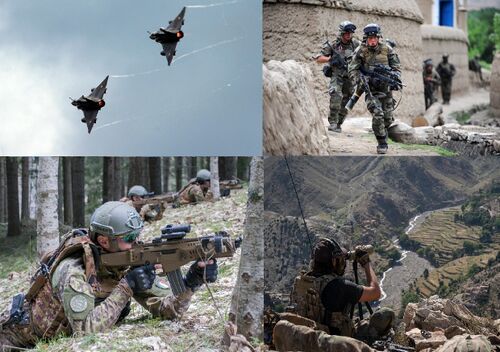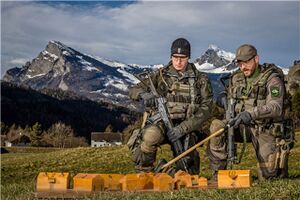1997 Sable Conflict: Difference between revisions
Ozycaevias (talk | contribs) m (1 revision imported) |
No edit summary |
||
| Line 46: | Line 46: | ||
===Parachute landings and the Battle of Sable=== | ===Parachute landings and the Battle of Sable=== | ||
[[File:MBAS-1.jpg|thumb|left|Coronel Nataniel | [[File:MBAS-1.jpg|thumb|left|Coronel Nataniel Godoy and the Tenente Coronel [[Antón Mira]] from ''Grupobatalla'' Godoy ]] | ||
===Encirclement of the 5e Brigade d'Infanterie de Montagne and the defense of Sable=== | ===Encirclement of the 5e Brigade d'Infanterie de Montagne and the defense of Sable=== | ||
Revision as of 02:39, 19 May 2019
| 1997 Sable Conflict | |||||||
|---|---|---|---|---|---|---|---|
 Top left: Notreceauen Prévoyance Portée combat aircraft conduct close air support operations in defense of the encircled 5e Brigade d'Infanterie de Montagne outside of Sable. Top right: Notreceauen infantry from the 14e Bataillon de Chasseurs Alpins, 5e Brigade d'Infanterie de Montagne during the Battle for Sable/ Bottom left: Aisling Cazadores from the 2nd Cazador Battalion, Second Division advancing towards Notreceauen positions outside of Sable. Bottom right: An Aisling Olheiro forward air controller observing the Sable Gap. | |||||||
| |||||||
| Belligerents | |||||||
|
|
| ||||||
| Commanders and leaders | |||||||
|
|
| ||||||
| Strength | |||||||
|
Peak: 36,000 |
Peak: 31,400 | ||||||
| Casualties and losses | |||||||
|
3,142 wounded 53 captured |
| ||||||
| X civilians killed | |||||||
The 1997 Sable Conflict was an armed conflict fought from May 1 until August 31, 1997, between the armed forces of Temuair and Notreceau. The combat was generally confined to the area around the town of Sable, a border town between the two nations located in the Vi Castis Mountains. The conflict was ended on August 31, 1997, when the government of Notreceau agreed to turn over control of Sable to Temuair, which is known by the Aislings as Sabaiza.
Background
The town of Sabaiza was taken by Notreceauen forces during the <war in 1987 to 1990ish> as they advanced through the Vi Castis Mountains. An Aisling counter offensive launched in 1990 pushed the Notreceauen forces back into the mountains, but was unable to successfully retake the town. Following the end of hostilities, the town remained under Notreceauen control, and was officially referred to by its Notreceauen name: Sable.
Order of battle
Timeline of events
Perpetration
The initial battle plan called for one parachute battalion, the 3/2 Alpino Para-Rifle Battalion to be supported by a squad of Olheiros and the 2nd Cazador Battalion after the initial landing, with the reaming forces of the Second Division along with the 1st, 2nd and 3rd Aplino brigades, pushing across the border and linking up with the parachute forces. The use of air assault forces were not considered due to the towns extreme elevation, and the problems inherent with operating helicopters at high altitudes. However, reconnaissance activity conducted by the Imperial Air Force of Temuair and members of the Cazador team selected to insert across the border at the start of the operation, determined that there was a full brigade operating in the area around Sable, as opposed to the regiment initially anticipated.
With this discovery, the plan was modified to include three parachute battalions, all drawn from the involved Aplino brigades. An ad hoc grupobatalla or battle group, was activated and included the 3/1 Alpino Para-Rifle Battalion, 3/2 Alpino Para-Rifle Battalion and 3/3 Alpino Para-Rifle Battalion. Grupobatalla Godoy was commanded by Coronel Nataniel Godoy, the brigade commander of the 3rd Aplino brigade. Due to the high and varied elevation of the town, and the limited confines of the anctipated landing zone, it was decided that only infantry would be dropped into the town, as there was an extremely high chance that any airborne combat vehicles dropped could land off target in the valley below or worse, be destroyed on landing by the rough terrain.
Initial attacks
The initial assault against Notreceauen forces began at 0330 am local time. All three company's of the 2nd Cazador Battalion, from the Aisling Second Division had been infiltrated across the border into the area surrounding Sable through the previous week. Their mission was to locate and designate targets for destruction prior to the initiation of a parachute assault against Sable proper. The Cazadores were to pinpoint and designate surface-to-air missile sites and Notreceauen early warning radar instillation before converging on Sable to direct airstrikes against targets in the town and to assist the Aisling parachute forces in ultimately securing the town.
The initial airstrikes were carried out by Athar LA-3 Sombra aircraft from the 18th Fighter Wing. The stealth attack aircraft were able to avoid detection by the remaining Notreceauen radar instillations and destroyed approximately 85% of their designated targets.
In an attempt to provide further protection for the transport aircraft ferrying the parachute forces, a diversionary air attack was launched at 0445 local time from Bieito-Cambra Imperial Air Force Base in Piet by the 21st Bombardment Wing and escorted by fighters from the 6th Fighter Wing. The Parada-Vara B-5A bombers and their escort of Athar L-5F fighters were directed to launch a large scale attack against Notreceauen Air Force installations in and around Passerville, as well as the Notreceauen naval facility in Passerville. It was hoped this maneuver would draw a large response from the Notreceauen defenders, and thereby give the transports a good chance of reaching their target without being intercepted.
The aircraft transporting Grupobatalla Godoy took off from Bieito-Cambra Imperial Air Force Base at 0515 hours and, escorted by fighters from the 3rd Fighter Wing, moved towards the airspace above Sable.
Parachute landings and the Battle of Sable
